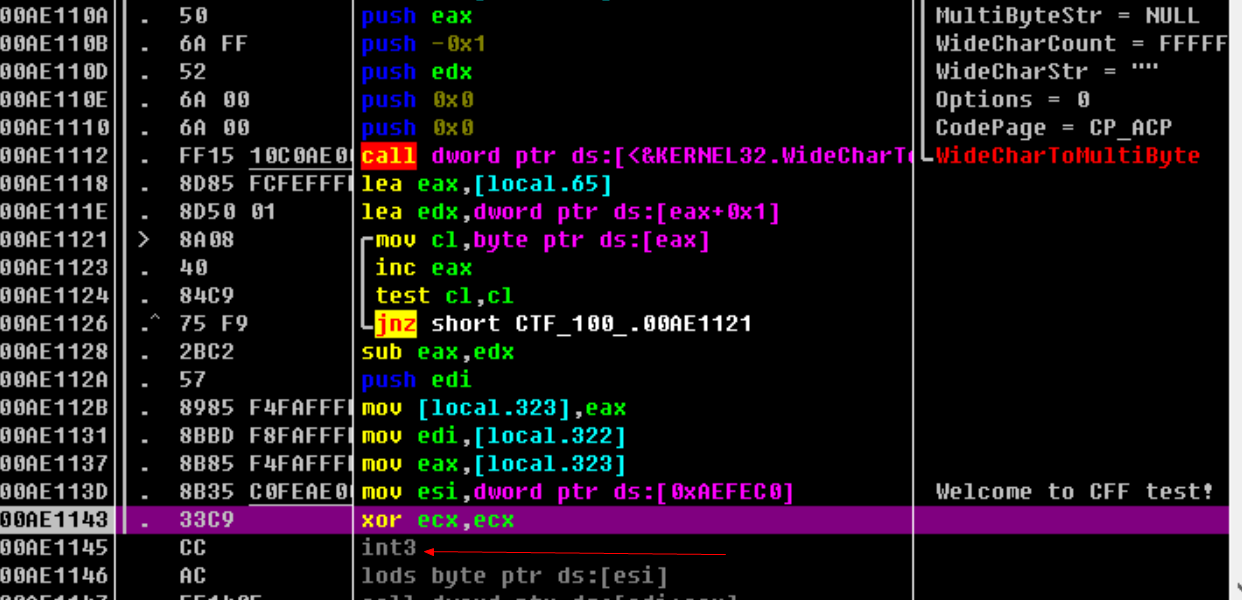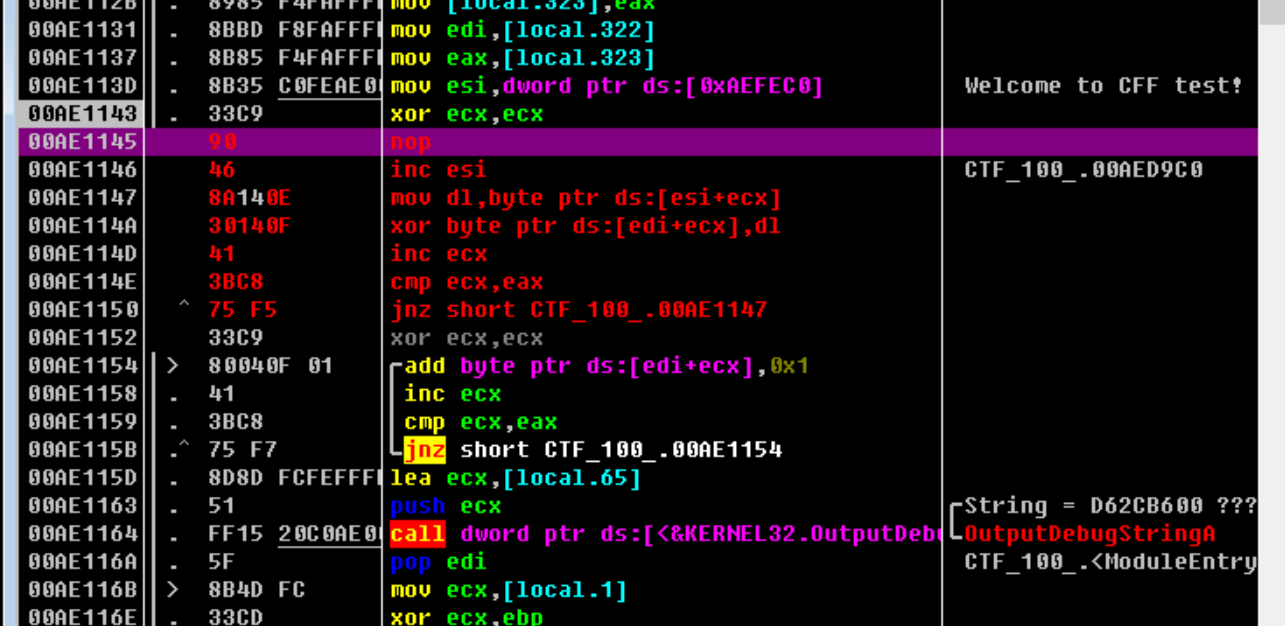下载附件后发现是个win32下的可执行文件,拖入IDA后,F5查看主函数但出现了错误,将main区域的汇编代码全部选择,右键点击create funcion 即可解决,但还是错误,原因说是sp的错误,这时点击option的general,将里面的Stack pointer打勾,发现mian函数最后return 的值为-4,将其改为0即可顺利反编译出主函数!
主函数的内容为下:
int __usercall wmain@<eax>(int a1@<edi>, int a2, int a3) { unsigned int v3; // kr00_4 __int16 *v5; // eax int v6; // esi __int16 v7; // cx char v8; // al unsigned __int16 v9[512]; // [esp+Ch] [ebp-504h] void (__cdecl *MultiByteStr[64])(int); // [esp+40Ch] [ebp-104h] if ( a2 != 1 )//有参数 { OutputDebugStringW(*(LPCWSTR *)(a3 + 4)); memset(MultiByteStr, 0, 0x100u); v5 = *(__int16 **)(a3 + 4); v6 = (int)(v5 + 1); do { v7 = *v5; ++v5; } while ( v7 ); WideCharToMultiByte(0, 0, *(LPCWSTR *)(a3 + 4), -1, (LPSTR)MultiByteStr, ((signed int)v5 - v6) >> 1, 0, 0); __debugbreak(); // inc 3断点!!!! v8 = *off_40FEC0; MultiByteStr[0](a1); JUMPOUT(dword_401150[0]); }
//没有参数 printf("%s ", off_40FEC0); wprintf(L"please input your password: "); wscanf(L"%s", v9); v3 = wcslen(v9); if ( v3 > 0x10 || !v3 || sub_401180((char *)v9) == -1 ) return 0; wprintf(L"{FLAG:%s} ", v9); return 0; }
可以清晰的知道,当我们输入的密码<=16且不为空,sub_401180((char *)v9) != -1,就会把我们的flag字符串输出!这里要注意的是,主函数的最开始对输入的参数进行了判断,参数会影响程序的运行方向,而且还有一个很明显的inc3断点!!!
进入关键函数sub_401180()函数查看,如下:
1 int __thiscall sub_401180(char *this) 2 { 3 char *v1; // ebx 4 LPWSTR v2; // eax 5 LPWSTR v3; // edx 6 WCHAR v4; // cx 7 unsigned int v5; // eax 8 __int16 *v6; // edi 9 WCHAR v7; // cx 10 __int16 *v8; // edi 11 __int16 v9; // ax 12 char *v10; // eax 13 __int16 v11; // cx 14 unsigned int v12; // eax 15 __int16 *v13; // edi 16 __int16 v14; // cx 17 int result; // eax 18 struct _PROCESS_INFORMATION ProcessInformation; // [esp+10h] [ebp-11A8h] 19 SIZE_T NumberOfBytesRead; // [esp+20h] [ebp-1198h] 20 SIZE_T NumberOfBytesWritten; // [esp+24h] [ebp-1194h] 21 struct _STARTUPINFOW StartupInfo; // [esp+28h] [ebp-1190h] 22 struct _DEBUG_EVENT DebugEvent; // [esp+70h] [ebp-1148h] 23 CONTEXT Context; // [esp+D0h] [ebp-10E8h] 24 int v22; // [esp+3A0h] [ebp-E18h] 25 int v23; // [esp+3A4h] [ebp-E14h] 26 int v24; // [esp+3A8h] [ebp-E10h] 27 char v25; // [esp+3ACh] [ebp-E0Ch] 28 int Buffer; // [esp+3B0h] [ebp-E08h] 29 int v27; // [esp+3B4h] [ebp-E04h] 30 int v28; // [esp+3B8h] [ebp-E00h] 31 int v29; // [esp+3BCh] [ebp-DFCh] 32 __int16 v30; // [esp+7AEh] [ebp-A0Ah] 33 WCHAR CommandLine; // [esp+7B0h] [ebp-A08h] 34 35 ProcessInformation.hProcess = 0; 36 ProcessInformation.hThread = 0; 37 ProcessInformation.dwProcessId = 0; 38 ProcessInformation.dwThreadId = 0; 39 v1 = this; 40 memset(&StartupInfo, 0, 0x44u); 41 memset(&DebugEvent, 0, 0x60u); 42 StartupInfo.cb = 68; 43 memset(&CommandLine, 0, 0xA00u); 44 v2 = GetCommandLineW(); 45 v3 = v2; 46 do 47 { 48 v4 = *v2; 49 ++v2; 50 } 51 while ( v4 ); 52 v5 = (char *)v2 - (char *)v3; 53 v6 = &v30; 54 do 55 { 56 v7 = v6[1]; 57 ++v6; 58 } 59 while ( v7 ); 60 qmemcpy(v6, v3, v5); 61 v8 = &v30; 62 do 63 { 64 v9 = v8[1]; 65 ++v8; 66 } 67 while ( v9 ); 68 *(_DWORD *)v8 = 32; 69 v10 = v1; 70 do 71 { 72 v11 = *(_WORD *)v10; 73 v10 += 2; 74 } 75 while ( v11 ); 76 v12 = v10 - v1; 77 v13 = &v30; 78 do 79 { 80 v14 = v13[1]; 81 ++v13; 82 } 83 while ( v14 ); 84 qmemcpy(v13, v1, v12);
//此函数为创建一个子线程,并进入调试状态 85 CreateProcessW(0, &CommandLine, 0, 0, 0, 1u, 0, 0, &StartupInfo, &ProcessInformation);
//此函数通知被调试程序继续运行 86 ContinueDebugEvent(ProcessInformation.dwProcessId, ProcessInformation.dwThreadId, 0x10002u);
//此函数等待被调试事件(时间无限),直到DebugEvent.dwDebugEventCode == 8(OUTPUT_DEBUG_STRING_EVENT)产生,即调用了outputdebugstring 87 WaitForDebugEvent(&DebugEvent, 0xFFFFFFFF); 88 while ( DebugEvent.dwDebugEventCode != 8 ) 89 { 90 ContinueDebugEvent(ProcessInformation.dwProcessId, ProcessInformation.dwThreadId, 0x10002u); 91 WaitForDebugEvent(&DebugEvent, 0xFFFFFFFF); 92 } 93 LOWORD(Buffer) = 0;
//此函数读取进程内存,并把数据储存至Buffer中 94 ReadProcessMemory( 95 ProcessInformation.hProcess, 96 DebugEvent.u.CreateThread.hThread, 97 &Buffer, 98 DebugEvent.u.DebugString.nDebugStringLength, 99 &NumberOfBytesRead);
//被调试程序继续运行 100 ContinueDebugEvent(ProcessInformation.dwProcessId, ProcessInformation.dwThreadId, 0x10002u);
//等待调试事件 101 WaitForDebugEvent(&DebugEvent, 0xFFFFFFFF); 102 Context.ContextFlags = 65537;
//读取进程内存,并把数据储存至Buffer内 103 ReadProcessMemory( 104 ProcessInformation.hProcess, 105 DebugEvent.u.CreateThread.hThread, 106 &Buffer, 107 DebugEvent.u.DebugString.nDebugStringLength, 108 &NumberOfBytesRead);
//得到中断线程的上下文信息,此时Context.Eip就是发生中断处的下一个地址 109 GetThreadContext(ProcessInformation.hThread, &Context); 110 v22 = 0x148A4690; 111 v23 = 0xF14300E; 112 v24 = 0x75C83B41; 113 v25 = 0xF5u;
//在发生中断处,将v22~v25写入进程内存 114 WriteProcessMemory(ProcessInformation.hProcess, (LPVOID)(Context.Eip - 1), &v22, 0xDu, &NumberOfBytesWritten);
//被调试程序继续运行 115 ContinueDebugEvent(ProcessInformation.dwProcessId, ProcessInformation.dwThreadId, 0x10002u);
//等待调试事件 116 WaitForDebugEvent(&DebugEvent, 0xFFFFFFFF); 117 LOWORD(Buffer) = 0;
//读取进程内存,并将数据储存至Buffer内 118 ReadProcessMemory( 119 ProcessInformation.hProcess, 120 DebugEvent.u.CreateThread.hThread, 121 &Buffer, 122 DebugEvent.u.DebugString.nDebugStringLength, 123 &NumberOfBytesRead);
//最后的判断 124 if ( Buffer != 0x2B5C5C25 || v27 != 0x36195D2F || v28 != 0x7672642C ) 125 result = -1; 126 else 127 result = -(v29 != 0x524E6680); 128 return result; 129 }
发现里面是一些windows api,相应的解释,注释已经给出。大概的操作就是在主进程(父进程)中开启一个子进程,并进入调试状态,利用子进程对运行的进程内存进行一些写入数据和读取内存操作。由于对子程序进行了调试的判断,因此父进程很难接收到事件的消息,所以动态调试很困难(但也可以!我最开始动态调试,但我疏忽了以为只有12个字节,所以只弄出了前12个(>o<),当然也可以全部弄出来,不过很麻烦!)。回到函数中,有几个关键的点:
①对进程的内存进行了写入数据的操作
②写入数据的地址在中断地址处
③取出进程内存的的数据,并比较数据
所以,我们要知道这个中断点在哪里,才能知道是对那个区域进行了写入操作,恰好主函数中有一个明显的inc 3中断操作,利用ollydebug打开,找到相应位置,如下

因此我们需要把v22~v25的数据内容写入,注意是小端顺序(在运行 调试到这里的时候,中途会直接终止,不过问题也不大,可以直接jmp这里,写入后的数据如下:

继续往下运行可以知道,把我们输入的数据与'elcome to CFF test!'进行异或运算,再把结果都+1,得出的数据通过调用outputdebugstring,使得waitfordebugevent函数接受到该事件,读取异或后的结果,与给出的数据进行比较。
到这里,程序的逻辑已经清楚了!,只需写出解密脚本即可
如下:
b=[0x25,0x5c,0x5c,0x2b,0x2f,0x5d,0x19,0x36,0x2c,0x64,0x72,0x76,0x80,0x66,0x4e,0x52] c='elcome to CFF test!' print(len(c)) for i in range(16): x=chr(ord(c[i])^(b[i]-1)) print(x,end='')
最后的运行结果:

结果即是flag!
解这道题可是花了我好长时间,一开始看writeup各种看不懂,(还没学到家呀!),查资料,这才慢慢弄懂了,但其实还有一些地方不太懂,就比如有参数才会运行的inc 3指令,程序是怎么get到这个地址的,还是有点没明白,希望有大佬可以告诉我,自己以后如果知道了,会来更的!关于里面的一些api函数,强烈建议大家看这个博客https://blog.csdn.net/xiammy/article/details/1675793,你们会收获到惊喜的!